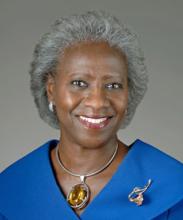
September, 2019
DR. VALANTINE'S FOOD FOR THOUGHT

Hannah A. Valantine, MD Chief Officer for Scientific Workforce Diversity
Have you ever had some aspect of your social identity negatively stereotyped by others? You’re not alone, as most of us have been subject to generalizations based on our gender, race/ethnicity, religion, or a host of other personal characteristics. In this month’s issue, I highlight origins and effects of stereotype threat and other sociocultural influences that can harm performance and even derail careers. In addition, check out how STEM volunteers are serving as role models for children along with potential ways institutions can address health
equity for their diverse stakeholders.
I Wanna Be a Scientist!
Choosing a career in science requires role models – of all types. As reported recently, the interactive STEM Volunteer Program sponsored by the American Association for the Advancement of Science hosts “Meet a Scientist” events, where children can ask scientists a variety of questions in a one-on-one setting. The conversation aims to provide kids role models by giving them a chance to speak with a diverse slate of scientists across genders, races, and ethnicities and from a variety of STEM careers. Retired NIH systems biologist Gertraud Robinson, who is a program volunteer, has found the program rewarding in many ways. She was thrilled recently when some of the children Robinson had worked with were asked to draw a scientist as part of a class project. “The majority of the drawings depicted women!” she was happy to report.
Stereotype Threat Dissected
Two decades ago, a classic study of stereotype threat suggested that when women perform math, unlike men, they risk being judged by the negative stereotype that women aren’t as good as men at math. The authors argued that this perception hinders women’s actual math performance, although more recent work suggests that additional factors are at play. A new study now shows that both numerical male dominance (more men than women working in a given field) as well as normative male dominance (negative stereotyping against women) contribute to the gender identity threat that negatively affects women’s career progression. Stereotype threat is not just limited to workforce issues, however – it can also affect health. For example, an NIH-funded study is now building on preliminary results suggesting that “values affirmation” to target racial stereotype threat can improve clinical interactions – and potentially reduce racial disparities in patients with uncontrolled high blood pressure.
Reaching Beyond the Triple Threat
Academic health centers (AHCs) have a tripartite mission of teaching, research, and clinical care. Biomedical researchers who excel at all three have been termed a “triple threat,” but doing so has become increasingly difficult in the context of modern medicine – and it may well be an unrealistic goal. A thoughtful new Perspective in Academic Medicine offers a fresh take on the concept, suggesting that a “Quadruple Aim” could add a new dimension to the traditionally tripartite mission of AHCs by focusing education, research, and clinical care on social determinants of health. Such an approach, the authors predict, will demonstrate and build upon interdependence between AHCs and their neighboring communities, as well as increase the diversity of ideas and experiences integrated into health systems.
Does Bias Contribute to Bad Chemistry?
New research explores the fact that chemical experiments are subject to a variety of human cognitive biases and social influences stemming from the human chemists who do them. This new research identified as-yet-unacknowledged human-based biases in both reagent choices and reaction conditions of chemical reaction datasets. In turn, the resulting “anthropogenic” (human-biased) chemical reaction data are used to train machine-learning models – which themselves are used to predict organic and inorganic synthesis reactions. In other work, unbiased data-science strategies may offer a tool to overcome inherent human biases. For example, researchers developed a mammography-based deep-learning breast cancer risk model that was significantly better at predicting risk than existing approaches. Moreover, it was equally accurate for white and black women, who are 42% more likely to die from breast cancer in part because they are less likely to be diagnosed.

The links above are pulled from the top news articles trending on the subject of diversity in science and technology.
The stories selected are not a reflection of the views of the National Institutes of Health.

